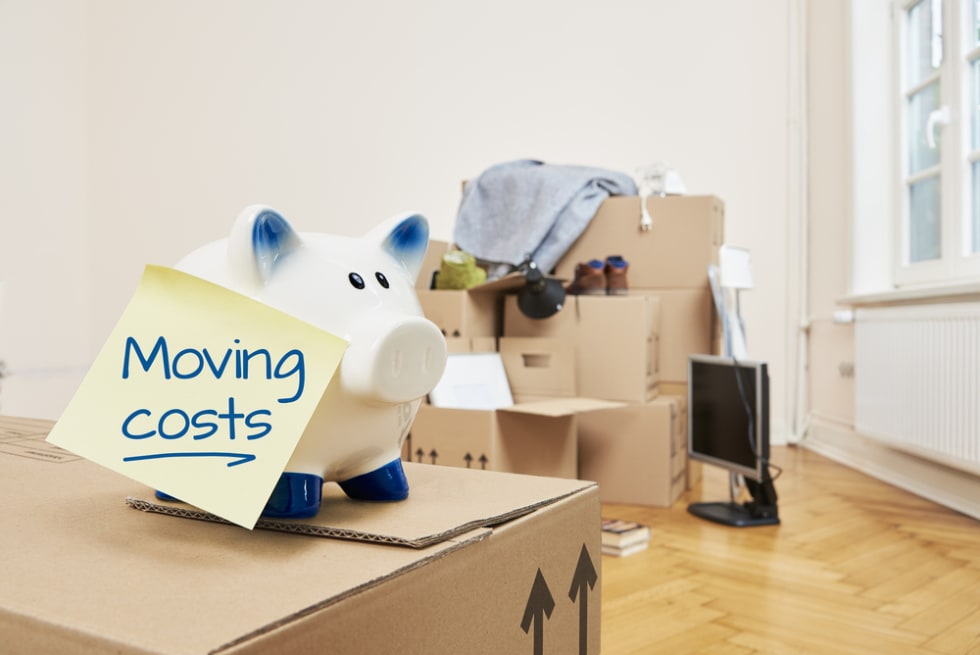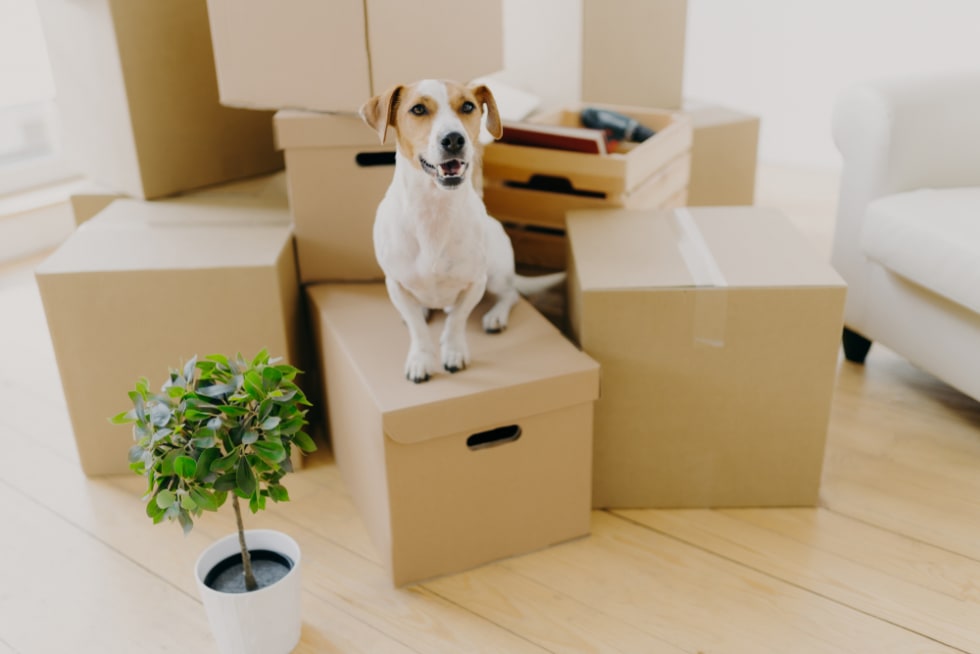How to Move to Another State: Guide + Checklist

Making a move is always a big deal, but moving out of state is an entirely different ballgame. Handling everything from exploring your new city to plotting the logistics of moving your belongings across state lines can be a herculean task.
If you want to handle your out-of-state move like a pro, you'll need a checklist to ensure that you stay organized and cover all your bases.
This in-depth moving-to-a-new-state checklist will break down all the essential steps of moving out of state. Here’s everything you need to know!
1. Visit the New City and State
If you haven’t already visited your new state in person, it’s important to do so. You want to build a basic foundation of information about your new home’s location.
It’s a good idea to spend at least a weekend exploring your prospective city or town. Here are a few things to do when visiting your new state:
- Go grocery shopping. Check out the selection of grocers, get an idea of pricing, and find a favorite place to shop.
- Take public transportation. Get an idea of what it’s like to travel by rail, bus, or another form of public transport.
- Do your favorite thing. If you love longboarding, for example, find a local park and skate the path.
- Explore different neighborhoods. This can help you narrow down your options when you’re choosing a neighborhood.
The key is to mimic your lifestyle as closely as possible in this new location.
If you’re in a situation where you can’t visit your new state before moving there, you’ll need to buckle down and perform some good old-fashioned research.
Most states, cities, towns have a website that’s full of relevant information, including what to do around town, who to contact for what, and information about particular neighborhoods.
Wikipedia can provide a general overview of a location. However, if you want information about a place from the people who actually live there, check to see if your chosen city or town has a Reddit page.
2. Research Neighborhoods
Once you have a good idea of what the city or town is like, it’s time to delve deeper into your search by researching local neighborhoods.
Most cities have multiple neighborhoods, so save time by narrowing your search down based on your lifestyle and preferences. Think about what’s important to you.
Here are some considerations to make when researching neighborhoods in a new state.
- Walkability. If getting around on your own two feet is your bread and butter, your neighborhood should be walkable. This EPA-backed interactive map provides an in-depth look at a neighborhood’s walkability and how it changes as you move through a city.
- Proximity to transit. For those who prefer the convenience of public transportation, a neighborhood that’s transit-accessible is a must. Be sure to check out the number of transit stops in a neighborhood and its connections.
- Bars and restaurants. If you plan to eat outside of the home, then a selection of bars and restaurants nearby is essential. Yelp is a great tool to view in-depth descriptions about local eateries and other establishments.
- Nearby parks. Whether you own a pet or just like getting outdoors, knowing the public park landscape in a neighborhood will help you determine whether it’s right for you. Check for details such as proximity, open hours, pet rules, and any public groups that meet at the parks in your neighborhoods.
- Schools. If you have children who will be attending school in the area, research the schools within your neighborhood. Depending on the layout of the school district, you may have many options. Narrow down your search by academics, sports teams, and other factors that may influence the quality of your child’s education.
Apartment List has a few different articles on the best neighborhoods in particular cities. If you're interested in moving to San Francisco, Atlanta, or Austin, read about the best neighborhoods to live there.

3. Research the Cost of Living in Your New State
When moving out of state, it's important to account for the difference in how far a dollar can go. Your new home may have a significantly different cost of living compared to your old home.
For example, the cost of living in Montgomery, Alabama, is 58.9% lower than the cost of living in New York City. In essence, your dollar may go a lot further in your new home state.
To create an accurate budget, it's essential to research the cost of living in any new state that you’re planning on relocating to.
Take note of differences in sales tax, food costs, utilities, and of course, rent rates. These are some of the biggest factors that will impact your budget.
4. Finding a Job
Finding a job in your new city is arguably one of the most important steps to take when moving to another state. A new job helps to convince new landlords of your stable financial position.
Additionally, it will help you cover moving costs, rental costs, and other associated expenses that could dig a hole in your savings.
If you’re lucky enough to be making a transfer within your company or joining the growing demographic of remote workers, notify your company’s Human Resources team.
They’ll help you update your tax forms and file the necessary paperwork.
If you’re looking for a new job outside your current company, it’s important to start your new job search as early as possible.
Whether you're looking to start a new career path or looking for a job within a specific industry, the Bureau of Labor Statistics can help you determine what the job market looks like in your state or local metro area.
It’s generally not recommended to move to another state without a job. However, it’s possible to find yourself needing to make the move before having landed a job in your new home. If so, visit job board sites such as Indeed, Glassdoor, or LinkedIn to find out who may be hiring ASAP.
5. Determine Your Budget
Determining your out-of-state moving budget will help you understand what you can comfortably afford and enable you to set spending limits to reach your goals.
That said, it’s easiest to set an accurate budget once you have narrowed down the neighborhood you want to live in, determined the cost of living in your new location, and have a job lined up.
In short, to build an accurate apartment budget, you’ll need to have as much financial information as possible. In addition to the financial changes associated with your new location, you’ll need to consider the following expenses:
- Moving Costs (hiring movers, buying materials, transport, etc.)
- Security Deposits (Usually equal to one month’s rent)
- Application Fees (varies by location)
- Down Payment & associated home-buying fees (if applicable)
- Furnishing Your New Home
These costs vary greatly depending on your personal circumstances, so do your due diligence to come up with accurate estimates.
To ensure that you aren't overwhelmed by unexpected expenses, utilize the 50-30-20 rule. This budgeting rule allows you to easily distribute funds from your income into three distinct categories, including necessities (50%), discretionary spending (30%), and debt relief/savings (20%).
If you’re not sure where to start when it comes to budgeting, try a budgeting app to keep your budget organized and hold yourself accountable.

6. Finding A New Home
Luckily, all your previous prep work leads to the handsome reward of starting your apartment search. Better yet, knowing how to move to another state is as simple as knowing how to use the internet.
Fortunately, with all the digital tools available, you can get pretty far in your out-of-state apartment search without ever leaving the comfort of your couch.
If you're not sure where to start your search, simply put together a list of all your needs and wants for your next apartment.
Apartment List can help you find the ideal home in your new state with all of the amenities and apartment features that you need.
You'll receive curated lists that offer a plethora of options based on the specific parameters you choose. In-unit washer and dryer? Check. Off-street parking? Check. New dream apartment? Check.
If you are buying a home, rather than renting, the process is a lot harder. It’s best-practice to conduct the home-buying process in-person rather than sight unseen.
We recommend a short-term rental in your new state. That way, you’ll be close enough to check out any homes on your radar and visit them in-person. You’ll also have time to get to know the area by actually living in it.
7. Set Up Tours
Touring an apartment is one of the most important parts of the rental process, as it is an opportunity to view the apartment and to ask relevant questions about the rental.
If you have the opportunity to view an apartment in-person, take it. Assessing an apartment is much easier when you can walk around and test things yourself.
However, if you go on a video or virtual apartment tour, it’s still possible to get a good idea of the apartment’s condition.
Ask for measurements of the apartment if you’re touring virtually so you can determine if it’s dimensions are the right fit for your current furniture.
In addition to measurements, there are a few other questions to ask during an apartment tour.
These questions include information about rent pricing, payment, fees, parking, pets, and more. It’s important to get this fundamental information before moving forward with the application process.
8. Send Applications
After touring apartments and narrowing down your list of potential new homes, it’s time to begin the application process.
The application process is the step that solidifies your intention to rent an apartment and submit yourself as a prospective tenant.
During the application process, you’ll be asked to fill out an apartment rental application, which is a straightforward document that is used to verify your identity, evaluate your financial background and current state, and assess your character.
You’ll need the following documents and information to complete an apartment rental application:
- Identification Documents (drivers license, state-issued ID, passport, social security card, etc.)
- Rental History Details
- Previous and Current Employment Details
- Proof of Income
- References
- Vehicle Information (reserved parking spots)
- Money for Application Fees (expect about $40 per unit)
In addition to this information, you’ll need to provide authorization to allow a landlord or property manager to run a background check and credit check on you.
Once you have submitted a completed application, your landlord or property manager will use the information to conduct the tenant screening process.
This process is used to determine whether you will be a good fit for the apartment, have the right credit score to rent an apartment, and have a history of being a good tenant.
If your credit score or rental track record isn’t exactly stellar, you may need to rent with a cosigner to increase your chances of being approved for an apartment.
You can usually expect to hear back in about 72 hours regarding your apartment application. However, this timeline can vary by location and you may even be approved for the apartment the day you submit an application.

9. Get Ready to Move Out
Once your application has been approved and you have signed your lease agreement (ALWAYS read it first), you’re all set to begin the move out process.
First, be sure to inform your current landlord, as early as possible.
If you are breaking your lease agreement, review your lease agreement to find an early termination clause.
Regardless of whether you find such a clause, you should speak with your landlord or property manager to determine what steps you can take to avoid major penalties.
You may be able to form an agreement with your landlord and sublet your apartment for the remaining portion of your lease.
Timing is essential here. You need to give yourself enough time to reach an agreement with your landlord, find and vet prospects, and finalize the agreement. In short, start the process sooner rather than later.
10. Find a Long Distance Moving Company
If you are moving your belongings across state lines, you’ll likely need to work with a long distance moving company to safely transport your belongings to your new home.
Hiring professional movers will take time, effort, and substantial funds. Generally, hiring professional movers will make or break a moving costs budget.
The average cost for full-service (loading, unloading, and transport) long-distance moves can vary greatly. However, a long-distance move from San Francisco to New York can cost up to $5,670 for a two-bedroom apartment.
Costs will vary greatly depending on whether you go with the full service option or simply require transport.
Full-service, long-distance moves include the loading and unloading of your belongings, as well as its transport. Standard service is just transport alone.
That said, you may be able to save by simply taking the time to research reputable companies near you and ask for quotes.
To get an accurate quote, you’ll need to have the following information ready, including moving distance, your home’s square footage, number of rooms, and number of large furniture pieces or appliances.
Moving companies will use this information to gauge how many movers they’ll need to send, the type of equipment they’ll need, and the distance of the move. That said, whenever you are moving to another state, it’s generally considered a long-distance move.

11. Or Consider Other Moving Arrangements
Hiring professional long-distance movers isn’t the only way to ensure that your belongings make it to your new home safely. When moving to a new state, there are several different moving options to choose from.
For the DIY lovers, the time-honored tradition of renting a u-Haul is the way to go. When renting a u-Haul, you can choose a standalone vehicle or a trailer that hitches onto your vehicle.
You’ll be responsible for loading it up, transporting it, unloading it, and dropping it back off at another u-Haul facility.
This option can help you save by eliminating the cost of professional movers, but because U-Hauls track mileage, you’ll be in for a major bill at the end of a long-distance move.
If you don’t want to deal with transporting your belongings, then renting a moving storage option like PODS is your best bet.
Renting a PODS container allows you to load up your container and have it picked up and transported to your new home. Once there, you can unload it and have it picked up at a scheduled time.
If you choose to skip a moving company service altogether, you’re going to have to downsize to fit your belongings in whatever vehicle you have at your disposal.
You’ll likely have to sell, donate, or give away many of your belongings. Moreover, you’ll be completely out of luck if your items are damaged during the trip.
However, you’ll save thousands in the process by eliminating the costs associated with transport (besides fuel) and moving. In the end, it’s up to you.
If you’re concerned about the cost of hiring professionals, there are some factors that will impact the cost.
For example, if you hire out of state movers during the winter months in the down season, you may save money and have more options to choose from as demand has died down.
Additionally, if you have fewer items to move, you’ll save big.
12. Get Moving Supplies & Begin Packing
Moving supplies include boxes, tape, wrapping paper, bubble wrap, and more. If you can’t find free moving supplies near you, you’ll have to purchase some before your move.
It’s important to get quality materials, as these are the tools that will keep your belongings organized and protect them during your move to another state.
So, how much will you need to add to your moving budget to cover the cost of quality moving supplies?
Data from CostHelper, puts the cost of moving boxes at:
- Small: Up to $1.70 per box
- Medium: Up to $2.79 per box
- Large: Up to $3.00 per box
- Extra Large: Up to $3.75 per box
That said, to come up with an accurate estimate, you’ll have to estimate the total number of boxes you’ll need.
You can use an online moving calculator to determine how many boxes and moving supplies you need.
It’s always best to overestimate the number of boxes and moving supplies you’ll need, rather than underestimating them.
Starting your packing process early on means that if you run out of supplies, you’ll still have enough time to purchase more before your move.
If you live near a home improvement store, such as Lowe’s, it should be very easy to find moving supplies at low prices.
You can also order moving supplies online. Some places sell moving kits with moving boxes and supplies that you’ll need based on your home’s size. If you order one of these kits online, double-check the shipping speed.
The last thing you want is to order something that’s going to take a month to arrive.

13. Transferring Utilities
Utilities can be a bit of a hassle. In addition to canceling utilities at your current home, you'll have to find the service providers in your new state and get your new service set up in your name.
Not to mention, you'll have to schedule it so you have service upon moving in. Here's a quick breakdown of the steps you can take to manage your utilities effectively during your out-of-state move.
- Contact Your Current Providers: Contact your gas, electric, and water providers, if those utilities are in your name. Tell them that you’ll be canceling your service at your current location. Tell them you’d like to schedule a shut off at a predetermined date.
- Transfer Your Utility Services: If you're moving to another state that your current provider offers service in, ask to transfer services to your new location. You can usually do this quickly and efficiently via an online portal or phone.
- Register New Services in Your Name: If you need to be set up with a new service provider, contact your new provider and get the service in your name. Schedule them for a day before you move in. You won’t want to move into a home with no lights or gas.
Perform these steps at least two weeks ahead of your scheduled move, as it will give companies time to process your request. Also, you won't have to worry about them for the rest of your moving process.
14. Canceling Local Memberships
The strangest thing about moving to a new state is realizing just how ingrained your life is in your current home. From library cards to parking passes, there are a ton of local memberships, subscriptions, and passes that you’ll need to cancel to avoid unnecessary charges.
Here’s a list of common local memberships and subscriptions to cancel before moving to a new state:
- Gym Memberships
- Country Club Memberships
- Grocery Chain Memberships (unless they’re national!)
- Check Local Subscriptions (meal delivery, monthly boxes, etc.)
- Coworking Offices
- Parking Passes
- Zoo Passes
- Magazines and Newspapers
- Cable and Internet Service
15. Figure Out Your Healthcare Insurance
If your new job is providing you with healthcare insurance, you’re in luck. Get documentation regarding your plan and locate new providers in-network.
However, if your new job isn’t providing you with healthcare insurance, head to Healthcare.gov to report your move to a new state and apply for healthcare insurance through the federal marketplace.

16. If you have Kids, Contact the Schools
Moving to a new state with children requires some serious administrative work to get school registration and enrollment handled.
Prior to your move, you’ll need to speak with your children’s current school and begin the process of record transfers. You may also be able to obtain a copy of their records yourself, to bring to their new school.
Either way, be prepared for many phone calls, emails, and a lot of red tape.
17. Change your Address
This one is a doozy. There are so many things that are tied to your address and when it comes time to move, it’s so easy to forget to change one address and end up with major headaches.
Luckily, using a change of address checklist can help you stay on top of change of address notifications.
Here are some of the most important change of address notifications you’ll need to make before your out of state move:
- The United States Postal Service ($1 fee to change address online)
- Government Entities (DMV, IRS, Social Security Administration, etc)
- Your Bank (and any other financial institutions with your address, including credit card providers, Venmo, Cash App, etc)
- Voting Registration Office
- Insurance Companies
You may have to take some time to draw up a longer list of address change notifications to make before your big move.
The upside? You might find some services that you want to cancel and end up saving money in the process.

18. Make the Move
Congratulations for making it this far! Moving day has arrived and you're not stressed. You've followed every step on this checklist and everything is smooth sailing since you’re so well-prepared. Way to go!
Be sure to set aside some time to say goodbye to close friends and family on the day of your move. You'll regret it if you don't.
19. Get New License and Registration
Most states have specific laws about how soon a new resident must obtain a state license. For example, in New York, new residents have 30 days to exchange their out-of-state drivers license and register their car in the state.
Look up your state’s laws to ensure that you obtain a new license and correctly register your car before the grace period is up. If you run out of time, you may face penalties or risk having your license revoked.
One trip to the DMV is all it takes.

20. Update Your Pet Registration
Register your pets! This is a big move for your pet, too! The stress may cause them to exhibit new behaviors, including the previously unknown talents of an escape artist.
Don't let your pet get loose with no identifying information that can help them return home. Register your pet with a new microchip and tags as soon as possible.
21. Have a Plan to Settle Into your New City
Just because you’re calling a new place home, doesn’t mean that you’ve actually made it your home.
It’s important to build up some connections with your new home. Moving to a new state is tough, there are many ways to make the most of it.
Draw up a plan of action that will help you settle into your new city.
Meet neighbors, explore the neighborhood, and begin this new stage of your life! You put in the effort, now is the time to reap the rewards.
A move can be stressful, but once you've settled, find a great group of friends to blow off steam and explore your new state with. Good luck and happy renting!
Share this Article



